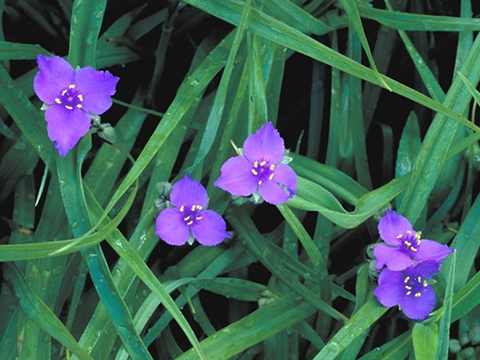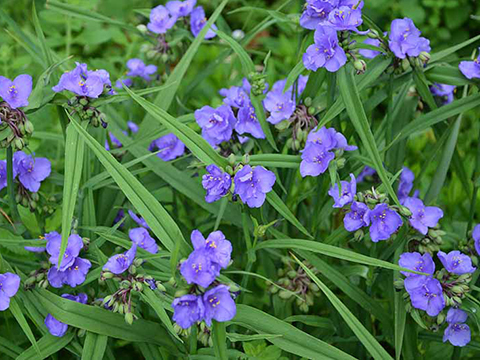Species Name: Tradescantia virginiana
Common Name: Virginia Spiderwort
Zone: 3 to 8
Light: Full Sun to Partial Shade
Soil Moisture: Moist to Medium to Dry
Soil Types: Sand, Loam, Clay, Gravel, Well drained
Fertility: Medium to Rich
pH: 5 to 6.8
Bloom Time: 6 weeks in late May, June and early July
Habit: Virginia spiderwort is a versatile and showy wildflower that prospers in average garden soils in full sun to partial shade. The plant grows as a 11/2 to 2 ft tall clump from thick fleshy rhizomes. Its 1” wide 3 petalled flowers range from violet to blue. Each flower blooms for only one day. Each flower opens at first light in the morning and closes up in the bright light and heat of the day. Although each flower is ephemeral the plant will continue to bloom over a 6 week period from late spring through early summer. The lovely mounds of deep green foliage covered in deep blue flowers are a beautiful addition to the perennial garden, rock garden, shade garden or massed along a garden path or as a tall ground cover for dramatic affect. Combines well with other native wildflowers.
The flowers are typically pollinated by bumblebees but are also visited by other species of bees, butterflies, flies and other insects. The foliage is fairly pest free and semi deer resistant with only occasional browsing by deer or rabbits.
Plants prefer moist to mesic conditions in fertile alkaline to acidic loamy soils with lightly shaded exposure, but it will tolerate drought conditions, poor soils and full sun with sufficient moisture. Under natural growing conditions spiderwort will self-propagate and naturalize from abundant seed. In the wild spiderwort is found in meadows, prairies, brushy thickets, open woodlands, and forest margins. It tends to be associated more with woody plant communities in the understory of forests and shrublands than with pure perennial communities of prairies and meadows.

Violet-blue flowers

Flowers on 1 1/2 to 2 ft tall plant


